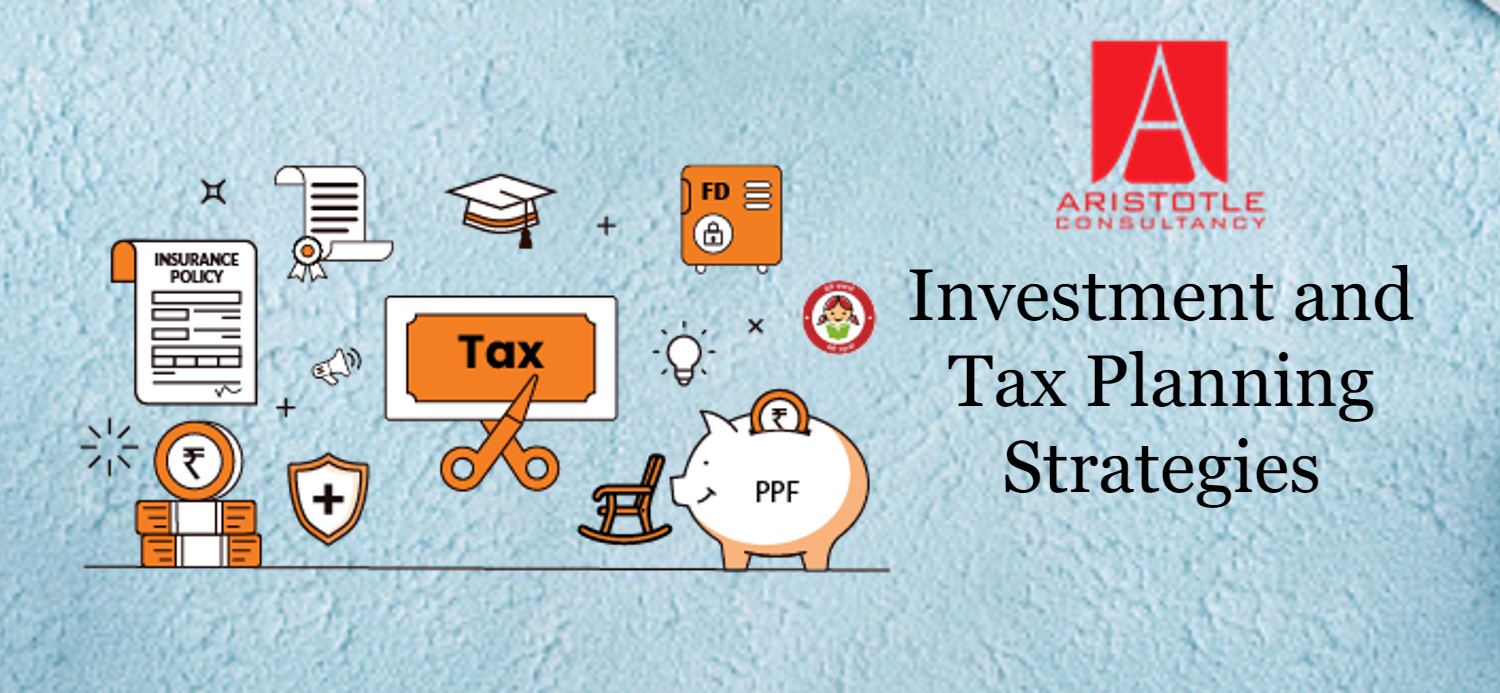Investment and tax planning strategies are critical components of financial success. By employing effective strategies, individuals can optimize their investment returns while minimizing tax liabilities. This blog aims to provide a detailed exploration of investment and tax planning strategies, covering key concepts, techniques, and tips to help individuals make informed decisions and achieve their financial goals.
I. Understanding Investment Planning: – Investment planning is the foundation of a successful financial strategy. To effectively plan investments, individuals should consider the following:
A. Setting Clear Financial Goals: Establishing specific, measurable, achievable, realistic, and time-bound (SMART) goals is essential. Clear objectives provide direction and help determine the investment horizon and risk tolerance.
B. Assessing Risk Tolerance: Understanding one’s risk tolerance is crucial in selecting appropriate investments. Factors such as age, income stability, and financial obligations should be considered.
C. Diversification and Asset Allocation: Diversifying investments across different asset classes (e.g., stocks, bonds, real estate) reduces risk and helps capture potential gains. Asset allocation determines the percentage of investments allocated to each asset class based on risk tolerance and financial goals.
D. Long-term vs. Short-term Investments: Long-term investments offer potential for higher returns and are suitable for goals with longer horizons, while short-term investments provide liquidity and flexibility.
E. Monitoring and Reviewing Investments: Regularly reviewing investments ensures alignment with financial goals and allows for necessary adjustments. Monitoring factors such as market conditions, asset performance, and economic trends is crucial for successful investment planning.
II. Investment Strategies for Maximizing Returns: – Implementing effective investment strategies can help individuals maximize their returns. Consider the following strategies:
A. Dollar-Cost Averaging: This strategy involves investing a fixed amount regularly, regardless of market conditions. By consistently investing, individuals can benefit from the average cost of purchases over time, reducing the impact of market fluctuations.
B. Value Investing: Value investing focuses on identifying undervalued stocks or assets. Investors seek opportunities where the market price is lower than the intrinsic value, aiming for long-term capital appreciation.
C. Growth Investing: Growth investing involves selecting stocks or assets with high growth potential. Investors prioritize companies with robust earnings growth, expanding market share, and innovative business models.
D. Dividend Investing: Dividend investing targets companies that distribute regular dividends. Investors seek stable income streams and potential capital appreciation through reinvestment.
E. Index Fund Investing: Index fund investing involves purchasing funds that replicate a specific market index, such as the S&P 500. This strategy offers broad market exposure, diversification, and typically lower fees compared to actively managed funds.
F. Tax-Efficient Investing: Tax-efficient investing aims to minimize tax liabilities by considering the tax implications of investment decisions. Strategies include investing in tax-advantaged accounts and utilizing tax-efficient investment vehicles.Proper handling and maintaining of all all tax compliances, GST Compliance as applicable from time to time is a very important task for any company.
III. Tax Planning: An Overview: – Tax planning is essential for optimizing financial outcomes and minimizing tax burdens. Key aspects of tax planning include:
A. Importance of Tax Planning: Tax planning helps individuals and businesses proactively manage their tax obligations, ensuring compliance with tax laws while maximizing available deductions and credits.
B. Basic Tax Planning Concepts: Understanding tax concepts such as taxable income, deductions, tax brackets, and marginal tax rates is crucial for effective tax planning.
C. Understanding Tax Brackets and Marginal Tax Rates: Tax brackets determine the percentage of income subject to taxation. Understanding marginal tax rates helps individuals make strategic decisions to minimize tax liabilities.
D. Utilizing Tax-Advantaged Accounts: Tax-advantaged accounts, such as Individual Retirement Accounts (IRAs) and 401(k)s, offer tax benefits. Contributions may be tax-deductible, grow tax-deferred, or enjoy tax-free withdrawals.
E. Capital Gains and Losses: Strategically managing capital gains and losses can help individuals offset taxable gains and potentially reduce overall tax liabilities.
IV. Tax Planning Strategies for Minimizing Liabilities: – To minimize tax liabilities, individuals can employ various strategies, including:
A. Retirement Account Contributions: Maximizing contributions to retirement accounts not only aids in saving for the future but also reduces taxable income in the present.
B. Tax Loss Harvesting: Offsetting capital gains with capital losses through tax loss harvesting can reduce taxable income. Losses can be used to offset gains and potentially provide tax benefits.
C. Charitable Contributions: Donating to qualified charities can result in tax deductions. Individuals should keep proper documentation of charitable contributions for tax purposes.
D. Maximizing Deductions and Credits: Strategically identifying and utilizing available deductions and tax credits can significantly reduce tax liabilities. Examples include mortgage interest deductions, education credits, and child tax credits.
E. Deferring Income and Accelerating Expenses: Shifting income to lower-tax years and accelerating deductible expenses can help manage taxable income effectively.
F. Estate Planning Considerations: Estate planning involves structuring assets and wealth transfer to minimize estate taxes. Techniques such as gifting, trusts, and life insurance policies can play a crucial role in preserving wealth for future generations.
V. Integration of Investment and Tax Planning: – Integration of investment and tax planning maximizes overall financial outcomes. Consider the following strategies:
A. Recognizing the Interplay Between Investments and Taxes: Understanding the tax implications of investment decisions ensures alignment with tax planning objectives.
B. Tax-Efficient Asset Location: Strategically locating assets across taxable and tax-advantaged accounts can optimize tax efficiency. High-growth or high-dividend investments may be better suited for tax-advantaged accounts.
C. Tax-Advantaged Investments: Investing in tax-advantaged vehicles, such as municipal bonds or tax-free savings accounts, can provide tax benefits while pursuing financial goals.
D. Strategic Asset Placement: Considering tax implications when allocating assets across different accounts helps minimize tax liabilities.
E. Regular Portfolio Rebalancing: Periodic portfolio rebalancing ensures that investments align with the desired asset allocation, manages risk, and may create opportunities for tax-efficient adjustments.
Investment and tax planning strategies are crucial for individuals aiming to achieve financial success. By understanding investment planning concepts and implementing effective strategies, individuals can maximize returns while managing risk. Simultaneously, employing tax planning strategies helps individuals minimize tax liabilities, ensuring more significant wealth accumulation over time. The integration of investment and tax planning is essential for optimizing overall financial outcomes. By staying informed, seeking professional advice when necessary, and periodically reviewing and adjusting strategies, individuals can navigate the complex landscape of investment and taxation, ultimately securing a prosperous financial futur.
Read more related blogs:
The Benefits Of Accounts Payable Outsourcing : Streamline Your Financial Operations
The Benefits Of Finance And Accounting Outsourcing For Small Businesses
Income Tax Return: Filing ITR For FY 2022-23? Important Tips
Increased Tax Exemption Limit on Leave Encashment: A Boon for Non-Government Salaried Employees
End To End Guide To Setting Up A Company In India
5 Key Financial Strategies For Small Businesses
Unlocking Business Growth: The Benefits Of Virtual Accounting Services
Types Of Outsource Financial Services That Businesses Can Choose






